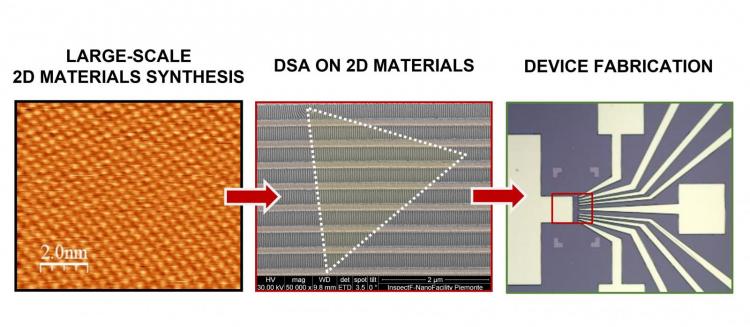
The aim of the EMPEROR project is to realize a new class of advanced photonic and electronic devices based on two-dimensional (2D) materials nanostructured by Directed Self-Assembly (DSA) of Block Copolymers (BCP). In recent years 2D materials, such as transition metal dichalcogenides (TMDs) and Xenes, emerged among the most burgeoning topics in condensed matter physics due to their applications in many technological fields, including electronics and photonics. Nevertheless, a bridging between 2D materials and reliable processes for device fabrication is still lacking. While the access to the nanometer scale required to explore the quantum properties is naturally inherent in 2D materials, where the third dimension is dramatically reduced to the atomic scale, their in-plane nanostructuring is still hindered by the intrinsic limitations of the conventional lithographic processes used for device fabrication. EMPEROR will overcome these hurdles by resorting to the DSA of BCP. Such an unconventional and low-cost lithographic technique enables the realization of highly ordered periodic templates with sub-10 nm feature size over large scale. This method is proposed as a universal technological platform to engineer a large family of 2D materials with different electronic behavior (from semiconducting to semimetal), allowing to probe and investigate novel optical, electronic and topological properties. Among the 2D materials available, the EMPEROR project will focus on two paradigmatic materials representing TMD and Xenes, namely tungsten disulfide (WS2) and Silicene, respectively grown via chemical vapor transport and molecular beam epitaxy onto supporting templates. On the basis of the peculiar electronic properties of the selected 2D materials, the potential architecture to be designed by DSA will be carefully assessed by fabricating two types of devices, among the broader range of applications possible using our designed platforms: (i) Ultrascaled Silicene-based field-effect transistors (FETs) featuring sub-10 nm channels; (ii) Nanostructured optoelectronic devices based on WS2 to electrically drive its photon emission. Out of these specific configurations, the so-established platforms will be therefore open to further investigation beyond the present proposal. EMPEROR hence approaches the sustainability of the European Green Deal in a comprehensive and innovative way where the realization of a plethora of low-consumption and low-power electronics and optoelectronic systems would allow a greater energy efficiency in civil applications (lighting, heating, air conditioning), industrial processes, critical infrastructures and mobility, thus contributing importantly to reduce the environmental impact of human activities. As communication is a key ingredient to the success of the project, throughout the whole course of EMPEROR, actions will aim at disseminating to a broad, specialized and non-specialized audience the project scope and the results.





